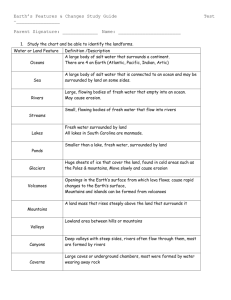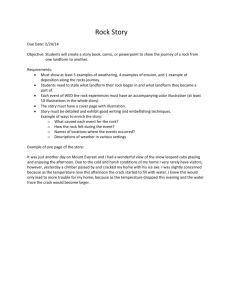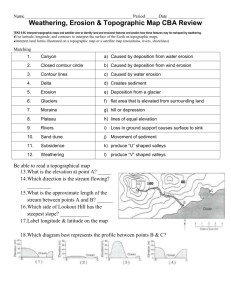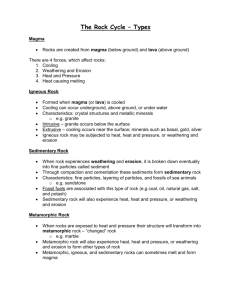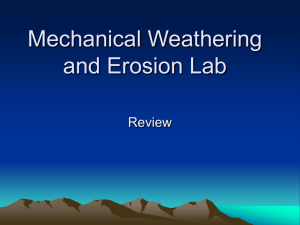1. Which provides the best evidence for the theory that faults and
advertisement
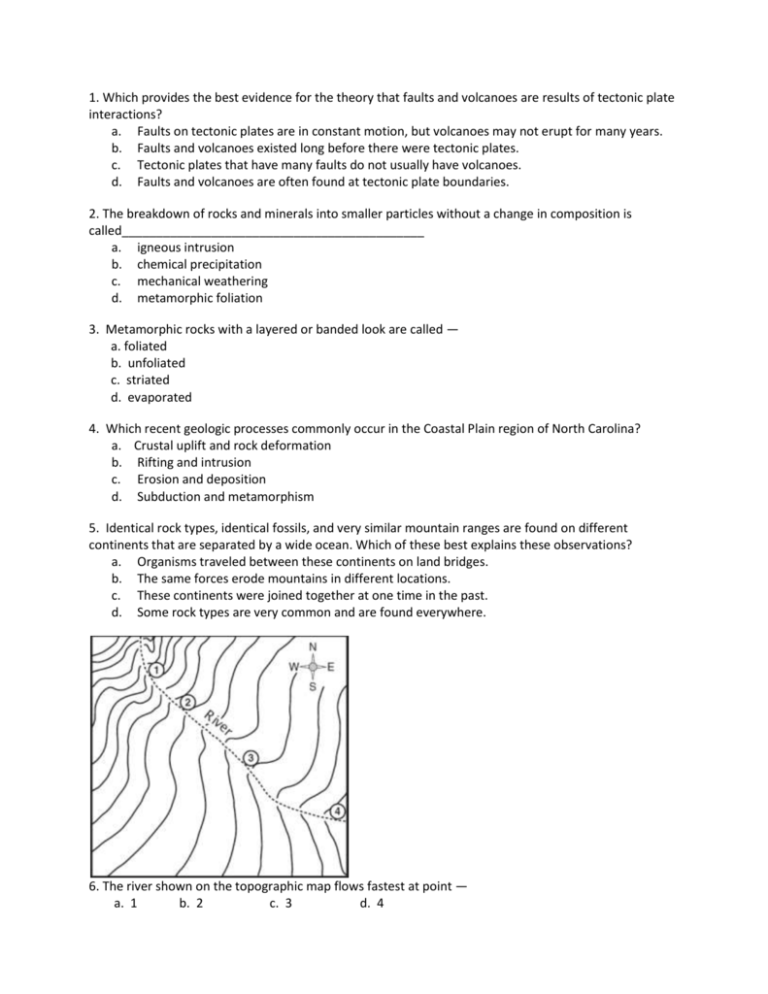
1. Which provides the best evidence for the theory that faults and volcanoes are results of tectonic plate interactions? a. Faults on tectonic plates are in constant motion, but volcanoes may not erupt for many years. b. Faults and volcanoes existed long before there were tectonic plates. c. Tectonic plates that have many faults do not usually have volcanoes. d. Faults and volcanoes are often found at tectonic plate boundaries. 2. The breakdown of rocks and minerals into smaller particles without a change in composition is called____________________________________________ a. igneous intrusion b. chemical precipitation c. mechanical weathering d. metamorphic foliation 3. Metamorphic rocks with a layered or banded look are called — a. foliated b. unfoliated c. striated d. evaporated 4. Which recent geologic processes commonly occur in the Coastal Plain region of North Carolina? a. Crustal uplift and rock deformation b. Rifting and intrusion c. Erosion and deposition d. Subduction and metamorphism 5. Identical rock types, identical fossils, and very similar mountain ranges are found on different continents that are separated by a wide ocean. Which of these best explains these observations? a. Organisms traveled between these continents on land bridges. b. The same forces erode mountains in different locations. c. These continents were joined together at one time in the past. d. Some rock types are very common and are found everywhere. 6. The river shown on the topographic map flows fastest at point — a. 1 b. 2 c. 3 d. 4 7. Which layer of the soil profile would be affected the most by weathering and erosion? a. 1 b. 2 c. 3 d. 4 8. The folding and faulting found in the rocks of the Appalachian Mountains of North Carolina were created by — a. collisions of continental plates b. wave action of prehistoric ocean c. the Coriolis effect d. heating and cooling of the prehistoric atmosphere 9. The major disadvantage of using solar panels to generate electricity is that solar panels — a. release toxic fumes into the air b. cannot convert energy efficiently c. are affected by cloud coverage and day length d. produce energy that cannot be stored 10. Limestone chips dissolve after they are placed in a beaker of dilute acid. Which geologic process is this most similar to? a. Faulting b. Folding c. Weathering d. Subduction 11. Which of the following processes will change a sedimentary rock into an igneous rock? a. Melting and crystallization b. Erosion and deposition c. Deformation and deposition d. Faulting and fracturing 12. Some fuels are classified as nonrenewable because they — a. produce toxic waste b. can be easily recycled c. come from deep within Earth d. require a long period of time to form 13. When granite is subjected to high enough amounts of heat and pressure to change it but not melt it, granite changes into — a. a metamorphic rock b. a sedimentary rock c. sediments d. an igneous rock 14. Which natural resource found in the Appalachian Mountains of North Carolina is a common source of energy? a. Bauxite b. Limestone c. Coal d. Zinc 15. How does the subduction of crustal plates influence the rock cycle? a. The processes of heating and melting of rock layers form the parent material for igneous rock b. The processes of cementing and compaction form sedimentary rock c. The parent material is provided for weathering and erosion d. The intense heat and pressure forms metamorphic rock 16. Why are seismic waves of an earthquake more strongly felt at the epicenter of an earthquake? a. Because millions of small movements of crust occur there b. Because most faults converge at the epicenter c. Because the epicenter is directly above the focus, the place inside the earth where the earthquake starts d. Because crustal plates rise and fall with the ocean tides 17. Why are wind, water, and gravity major agents of erosion rather than weathering? a. Because weathering is often limited to physical changes in earth material b. Because weathering is often limited to chemical changes in earth material c. Because erosion involves the stationary processes that break down rock d. Because erosion involves movement of earth materials from one location to another 18. From a scientific perspective, which of the following sequences of action is the best way to solve the problem of wetland erosion? a. Add sediments, plantings and monitor plantings b. Dredging, sand bags, plantings c. Dredging, hard stabilization, plantings d. Hard stabilization, sediment transport, pesticide treatment 19. Which more likely to prevent mass-movement events? a. Constructing buildings in stream drainage paths b. Clear-cutting trees from the side of a mountain c. Paving roads next to sloping hills d. Contour plowing of crop areas 20. How does the replacement of large land areas with concrete and asphalt affect the land? a. It changes the bedrock of underlying layers of soil b. It prevents the dynamics of the rock cycle c. It increases the amount of groundwater in porous rock d. It increases the erosion of sediments by increasing runoff 21. Why does mining of coal and other natural resources often result in environment pollution? a. Mining pollutes the air near streams b. Mining produces acid precipitation near streams c. Mining creates waste material which can flow into streams d. Mining strips the surface of the land near streams 22. Of the following, which energy source produces the least amount of solid waste? a. Coal b. Natural gas c. Oil d. Peat 23. Which alternative energy technology could take advantages of land and sea breezes in coastal NC? a. Biofuels production b. Wind farms c. Solar energy panels d. Nuclear fusion 24. Why would citizens be advised to recycle plastic products? a. Because the products are not biodegradable and would therefore accumulate b. Because this would increase the consumption of petroleum products c. Because this would decrease the amount of green industry jobs d. Because the products can be made into inexpensive public art 25. If you were to examine the Appalachian Mountains of western North Carolina, you would discover that many of the rocks in this mountain range are igneous. What does this tell you about the past? a. Involved with earthquakes b. Involved with mass movements c. Involved with volcanic activity d. Involved with deposition of weathered material 26. Earthquakes produce three types of seismic waves. Which one of these waves is the most destructive to buildings? a. P waves b. S waves c. L waves 27. When rocks along strike-slip fault lines catch and build up pressure, they eventually break and release a great deal of energy. The point from which this energy is released is known as the ____________________. a. Epicenter b. Focus c. Energy fissure d. Fracture 28. When looking at an igneous rock it is noticed that the crystals of the rock are coarse. This property tells us that the rock cooled ______________________. a. Intrusively b. Extrusively 29. The map above shows the earthquake activity in North Carolina over the past two decades. Based on the information which section of North Carolina is most likely to experience an earthquake? a. Piedmont b. Mountains c. Outer coastal plain d. Inner coastal plain 30. Which type of rock is most likely to contain fossils? a. Metamorphic b. Igneous c. Sedimentary d. Felsic 31. Which of the following isn’t a type of mass movement? a. Slump b. Creep c. Mudflow d. Avalance 32. Which of the following isn’t a factor/force involved with erosion? a. Gravity b. Wind c. Tension d. Water 33. Which human impact on the environment is most destructive to biodiversity? a. Pollution b. Deforestation c. Urban sprawl d. Agricultural techniques 34. Why does Earth experience precession? a. Because the Earth revolves around the sun every 365 days b. Because of the movement of the circumpolar stars and Polaris c. Because the Earth is the third planet from the sun d. Because the plane of the moon’s orbit is tilted from the Earth’s elliptical plane 35. Which is true about Earth’s motion through space? a. The earth’s revolution changes the Sun-Earth gravitational pull b. The Earth’s rotation causes annual changes in its surface temperature c. The tilt of the Earth’s axis and its revolution around the sun produces seasons d. The Earth’s precession affects the amount of heat reflected from it surface. 36. Which of the following chemical reactions produce the sun’s energy? a. Helium nuclei are combined by nuclear fusion b. Oxygen is present to cause combustion of solar fuel molecules c. Hydrogen nuclei combine through nuclear fusion into helium d. Helium and oxygen break down through nuclear fission 37. How is solar energy essential to plants? a. Solar energy maintains the internal temperature of the plants b. Solar energy is converted to chemical energy used by the plants c. Solar energy signals the plants to release leaves in the fall d. Solar energy regulates the consumption of oxygen by the plant 38. How does the sun’s energy affect food webs on Earth? a. The ultraviolet radiation of the sun generates ozone for plants to support all life. b. The wavelengths of visible light stimulate plant cells to produce energy compounds by photosynthesis c. The microwaves emitted by the sun stimulate animal reproduction in the rainforest 39. How is the balance of heat energy maintained in the oceans? a. The sun’s energy is equally distributed throughout the oceans b. The tides transfer heat energy across the oceans c. The movement of waves transfers heat energy throughout the oceans d. Heat energy is cycled by currents between the equator and the polar regions. 40. When is the subsurface phase of the water cycle completed? a. When groundwater emerges in places where the water table interacts with the ground surface b. When precipitation produces runoff into streams above the surface c. When water remains in the ground as part of the water table d. When water infiltrates the ground after rain, sleet, or snow accumulate 41. In what type of soil would seepage of groundwater into streams occur the slowest? a. Fine sand b. Gravel c. Fine clay d. Silt 42. How would several wells in a given area affect the balance of groundwater recharge and discharge? a. The wells would provide dissolved oxygen b. The wells would increase the water table level by adding water from runoff c. The wells would deplete the groundwater which is usually supplied by percolation from rain d. The wells would provide storage areas for groundwater to maintain the water level 43. When a sewer pipe breaks near a stream which would most likely occur? a. Increase in salinity b. Decrease in dissolved nitrogen c. Decrease in dissolved oxygen d. Increase in pesticides 44. Why do planes fly in the stratosphere, the second-lowest layer of the atmosphere? a. To avoid storms and other weather events b. To receive better radio communication c. To fly at supersonic speeds without air resistance d. To avoid changes in air pressure 45. The earth’s atmosphere is mainly composed of which two gases? a. nitrogen and oxygen b. Carbon dioxide and nitrogen c. methane and oxygen d. oxygen and carbon dioxide 46. How does a cold front form? a. Warm air advances and replaces cold air b. Cold air advances, forcing warm air to rise c. Warm and cold air masses mix and meet d. Warm and cold air masses have no relative advancement 47. How are hurricanes and tornadoes related to air masses? a. They form within air masses b. The form where air masses meet c. They form where air pressure is the same d. They form where air temperatures are the same 48. On an August afternoon in NC, the barometric pressure is 29.92 inches and falling. What weather condition is likely to happen? a. Clearing skies and cooler temperatures c. An imminent storm b. Continued fair weather d. Conditions will slowly improve 49. Where would the highest amounts of acid rain most likely be found? a. Over the ocean c. In urban areas b. In the forest d. In the mountains 50. What is the major difference between weather and climate? a. Air temperature b. Air pressure c. Humidity d. Time 51. What type of pressure system is a hurricane associate with? a. High b. Medium c. Low 52. Which of the following is an example of climate? a. The current temperature in Pinehurst, NC b. The relative humidity in Raleigh, NC c. The average current temperature in a region d. The average temperature in Raleigh, NC over the past 30 years 53. Many of the biomes that exist on Earth can be found in the western part of NC. What is the primary reason for the existence of such a wide range of biomes in this area? a. The rivers and lakes in the mountain areas b. The wide range of altitudes of the mountains c. The types of rocks that make up the mountains d. The wind and water erosion of the mountains 54. How is biodiversity essential to the environment? a. Biodiversity decreases the chance that at least some living things will survive in the face of large changes in the environment b. Biodiversity decreases the stability of the ecosystem c. Biodiversity adds to the aesthetical value of the environment and reduces the amount of genetic material in the environment d. Biodiversity adds to the aesthetical value of the environment and increases the amount of genetic material in the environment 55. Which human activity would be most destructive to the biodiversity of the biosphere? a. The burning of wood and coal in rural areas b. The release of species of freshwater trout in lakes c. The removal of plants from the food webs they support d. The removal of erosion barriers from forest boundaries 56. Which alternative energy technology could take advantages of land and sea breezes in coastal NC? a. Biofuels production b. Wind farms c. Solar energy panels d. Nuclear fusion 57. Why should the farming industry adopt sustainable agriculture practices? a. To increase the use of irrigation systems b. To increase the number of non-point sources of water pollution c. To increase the amount of erosion and deposition d. To reduce the environmental degradation and economic losses 58. Which change would most likely occur as a result of rapid increases in the global population? a. The price of labor to harvest raw food supplies would decrease b. The price of transporting food would cause lower of food prices c. There would be a high demand for limited natural resources d. The present global management of natural resources would remain the same 59. Why would citizens be advised to recycle plastic products? a. Because the products are not biodegradable and would therefore accumulate b. Because this would increase the consumption of petroleum products c. Because this would decrease the amount of green industry jobs d. Because the products can be made into inexpensive public art e. nitrogen cycles 60. Which type of clouds are tornadoes associated with? a. Cirrus b. Cumulonimbus c. Stratus d. Cumulus


